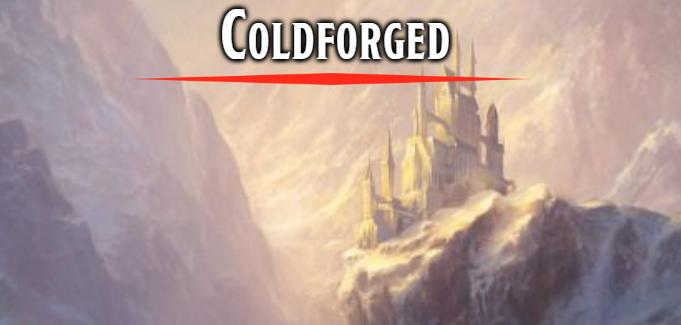
Coldforged Atlas: Physical Terrain Part 1
I continue rushing headlong into the second year of writing Coldforged material, and this year I hope to cover enough topics in preparation to print as is possible. I hope we’re in the home stretch. I’m working on the Atlas currently, trying to make sure the physical descriptions of what the land feels and looks like match up. Le’ts dive in.
Physical Traits
Little is more important to an atlas than the description of what the region actually entails. Ensuring the descriptions of sweeping plains, towering mountains, and stinking fens are clear and appropriate is of the utmost importance when creating a world and, to that very point, when the atlas is created.
I’ve had many of these images, like much of the campaign setting, in my head for ages, and finally getting them on paper is a wonderous relief. Let us begin!
The Forest of Lev
The expansive Levishan forest stretches from the banks of the Asirialli River, west to the great scar and the Ironarm Mountains, and fades slowly into the taiga of the northern wastes. It is mostly hardy evergreens that reach straight and tall into the sky. Rocky ravines separate craggy hills from each other as burbling streams gather into deep, cold glacial ponds. Meadows are fairly common, it is a place of idyllic charm, unhampered by tall undergrowth in the summer, and covered in a blanket of white and green in the winter.
The Levishan forest is a sturdy and powerful Evergreen forest, abundant in redwood, spruce, fir and pines. The Eastern coast, bordering the Indomduns Ocean, is jagged and windswept cliffs. The green of the forest often rides directly up to the ocean, and the beauty of the cliffs and the quantity of coves, sounds, and jagged rock outcroppings are legendary. Barbed islands are each year worn away by the ice that comes down from the north and solidifies along the ocean boundary, forming ice pathways to islands inaccessible for most of the year.
The forest’s thickness fades as it merges with the Taiga of the wastes in the north, the great trees shrinking in both size and girth until it eventually fades into the brush and then to the windy north. Here the land is rocky, with trees clinging to life here and there among the depressions of soil and water. Spring and summer bring wave after wave of beautiful ferns and flowers that covers the forest floor.
The central portion of the forest is mostly hardy evergreens that reach straight and tall into the sky. Rocky ravines separate craggy hills from each other as burbling streams gather into deep, cold glacial ponds. Meadows are fairly common, it is a place of idyllic charm, unhampered by tall undergrowth in the summer, and covered in a blanket of white and green in the winter.
The southern edge of the forest butts against, and sometimes rolls over, the Asirialii River, flowing from the Ironarm Mountains along to Niaralli Lowlands until arriving at Undine bay to empty. While it is still rocky, the trees here mix with the southern deciduous and the undergrowth thickens in the presence of the river. There are dozens of small ponds and streams that coalesce into the Ashirialli which creates an immense wetland that forms the southern, almost impassable border. Ragged hills, steep ravines, and thigh deep much keep many of those who would trespass limited to the three well-guarded roads heading north.
Eastwards, the forest climbs the Fingers of the Ironarm Mountains, stretching up to the point where the pines can no longer grow, starting out with towering trees until all that is left are twisted, miniature versions of their once-vaunted types. Brush and hearty shrubs thrive here, in the land is rugged, harsh, and wild terrain where mountain and forest and gorge intertwining in perilous ways.
The Imerian Peninsula and Undine Bay
The Imerian peninsula is bordered on the west by the Indomnus Ocean, and on the east by Undine bay. The ocean ward shore is rocky and island ridden, with a rough surf that deters many a trader from coming ashore here on the peninsula. There are a number of calm harbors and bays, however, protected by natural breakwaters. The Shrubs and trees here are flexible and determined, clinging to the rocks and cliffs as if by some indefatigable spirit. The islands themselves are rocky and jagged, hiding coves, caves, and inlets in abundance.
The east coast of the peninsula is much calmer, having sheltered the bay from the worst of the storms via the peninsula itself. The golden, sandy beaches are often calm, with a strong breeze that warms in the spring and summer and cool in the winter. The towns and cities along the coast thrive on the trade that makes its way through the Harpies Nest, building long docks and great piers to facilitate as much of it as possible.
The central area of the peninsula is smooth and rolling hills that slowly rise up into the Teeth if Imeria, a small mountain range at the end of the peninsula that bites at the sky and tower over everything around them. Covering the peninsula except for the very peaks of the Teeth is a light mixed forest of thin pines and arrow-straight oaks and maples. Shrubs make up the vast majority of the undergrowth, though numerous seasonal ferns and other plants also populate the area. The trees and shrubs here continue around the bay, into the lowlands north of the bay, and all the way around to the Gray Morass.
The coast of Undine bay from the Peninsula to the Gray Morass in the south is one of the sandy beaches, gentle rocky outcropping, and gently rolling hills. The hills around the bay lead inward and get moderately rougher, but remain predominantly forested. The beaches are golden and mild, and the few cliffs aren’t terribly severe. South of the Rilus River, there are several notable steep and forested cliffs overlooking the bay. The Undine woods, the southernmost area of the coast prior to the Gray Morass, is a thick and imposing wood that grows wild and strong, likely fed by the power of the Gray Morass itself.
Northern Highlands
Spreading south of the Asirialli River, from the Indomnus ocean to the Thraxian forests in the west, and to the Toldiri Hills and the Undine bay in the south are the Northern Lowlands. To the west, abutting the ocean, lie the ruins of Jeslith on a rolling, gorgeous hilly land, resplendent with streams, ponds, gentle hills, and bounteous copses of trees. It grades ever so downward until it reaches the rushing Imer River, cutting a vast, powerful, and often uncrossable boundary, the river, is swift and, in most areas, bounded by dangerous cliffs and unstable slopes.
Past the Imer River, the densely wooded valley continues to spread out and upwards towards the Thraxian forest, becoming wilder and untamed the further west it spreads. The smooth hills fall away into vast, windswept steppe peppered with buttes, monoliths, and other magnificent structures both small and large before abruptly shifting back into the dense forest of Thrax as it stretches east. As the lowlands lean east, though, the steppe spreads out and down, becoming a pleasant and fertile plain, interwoven with small rivers whose sustain long and wide tracks of woodlands, copses of trees, ponds and streams as it joins the
To the south, the lowlands shift gently into a mild mix of pleasant pasture land and forest, interspersed and intertwined with each other, broken by calm streams, deep ponds, and plenty of rolling hills. As it creeps towards the Toldirii hills, its own hills get rockier and sharper, interspersed with the wild boulder and rock outcropping that interjects itself into the generally pleasant landscape. Toward the end of the lowlands, the hills become incessant, breaking up the mild terrain, with caves, gorges, and other geographic features becoming more regular until the entire landscape is littered with massive rock outcroppings, random boulders, and towering granite formations.
The Toldiri Hills
The Toldiri hills are rough and tumble hills interspersed with rocky outcroppings and cliffs, massive monoliths, and winding streams. It is tough, but not impossible, terrain, with many paths that wind their way slowly through the area. In the north, surrounded by the roughest hills and the highest cliffs is the massive Toldir valley. It is here; legend has it, that the hrondring was first created, and it is here that many of the tribes still make the pilgrimage. The ruined city that occupies much of the valley is held in deep respect and cordoned off for each of the tribes to occupy on their travels, each having their own monuments, temples, and sacred spaces within. The city surrounds are large lake with a central island containing a forum and a few other buildings.
To the south, the hills get higher and steeper, eventually culminating in a huge caldera that contains within it a lake riddled with islands. From this lake, the river that spreads out into the Gray Morass is fed. The hills here are harsh and riddled with caves, valleys, and lakes that make it the perfect retreat for those who wish to remain unfound.
The western edge, that borders the Undine bay, is much rockier, with few passes that cleanly enter the hills. Escarpments are common ad the bay quickly climbs into the hills, and it is clear that anyone entering the region will be quickly spotted and dealt with in quick fashion. The woods here are sparse, and mostly to the south.
To the east, the hills gently melt down into the central plains, forming a pleasant transition from the rocky hills, though it does maintain the high rock outcroppings, plenty of caves, and stone plateaus that rise for a significant portion of the area. It is the home of many tribes of Hrondring as well as numerous bandits and other foul humanoids preying on those within.
The hills fade into the great southern forests, the hills keep their rocky character, but become covered in dense mixed forests, concealing hidden coves, high rock plateaus, and many streams and rivers. This is the part of the Toldiri that is most forbidding and difficult to traverse and is home to the crumbled Eshkin Kingdom, littered with ruins from a bygone age.
Well, Until next time!



